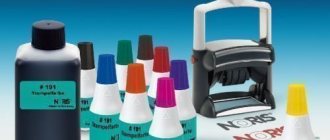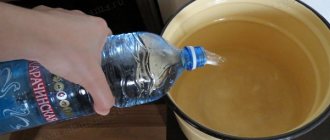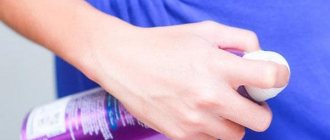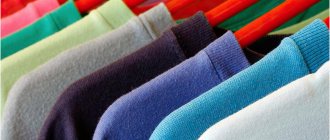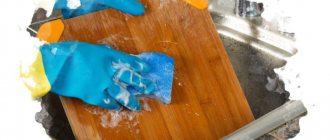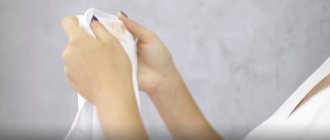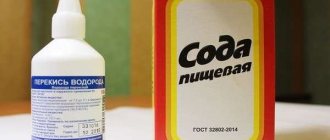Choosing paint for dyeing clothes
We live in an age of abundance. The chemical industry offers such a rich assortment that it can be difficult to decide what paint to paint clothes with. It is simply not possible to define all types of dyes in one article. Therefore, we will limit ourselves to a list and a brief description of the main types of things used to paint things.
- Aniline - recommended only for dyeing products made from natural fibers.
- Oil ones are the most difficult to use, but with guaranteed and long-term results.
- Acrylic - can be used not only for cotton, but also for silk fabrics.
- Water-glycerin - used to obtain radical dark shades (for example, black or dark blue).
Pigment selection
What natural dye can be used to dye fabric:
- tea; cocoa - for a chocolate shade; rich coffee will turn black; onion peel; wolf berries - red; blueberries, blackberries for a juicy purple color; cranberry; walnut peel - beige or sandy; spinach, sorrel, elderberry leaves will color the canvas green; beets for the pink to burgundy range; cabbage; turmeric, celandine – orange, red; carrot juice, sea buckthorn.
Tip: to consolidate the results of using natural pigments, use vinegar essence and salt.
How you can dye things: stores sell a special fabric dye in the form of a liquid, paste, spray or powder. The main advantage of such a tool is that there are clear instructions, it’s difficult to make a mistake. Some people use food coloring.
Is it possible to dye fabric with hair dye: yes, but the color may not be very saturated. Especially if you use dark shades on heavily faded material. If you are not careful, the material will become stained.
Natural fibers are painted with acrylic paints. It is not possible to fill artificial or synthetic organza with pigment using acrylic paints.
White fabric dye comes in acrylic, aniline, or spray form. It is applied to pre-bleached fabric to give a pure shade.
What fabrics can be dyed?
In principle, you can dye any fabric with your own hands. But, of course, subject to certain conditions. However, you should know that not every fabric modulates color equally well. Thus, the intensity of staining may vary. It is important to note:
- You should always refrain from dyeing synthetic fibers such as polyester.
- Fabrics containing 60 percent or more natural fibers can be dyed easily and without problems. These include cotton, viscose, linen, satin, chintz, etc.
- The seams of clothing are most often made of synthetic threads. They absorb color with difficulty or not at all and therefore, in most cases, retain their original color. There may be a clear contrast. Before you paint things, pay attention to this.
Pros and cons of acrylic paints
Colors based on polyacrylates have found the widest use among needlewomen. Sold in jars, tubes, cylinders, they come in matte, glossy, and with mother-of-pearl.
- quick drying;
- dilution with plain water;
- easy application;
- the ability to mix shades;
- low price;
- economical in consumption;
- brightness, color fastness;
- no need to fix the drawing;
- hypoallergenic, pleasant smell.
The work does not require any special skills; anyone can apply a stencil and make a drawing. But the disadvantages of paints also need to be taken into account:
- The shelf life of the colors is short; after their expiration, the properties of the products deteriorate;
- the pigment must be applied carefully - the substance spreads over the fabric;
- After application, a dense, non-stretchable area is formed - the elasticity of the material is lost.
Hand dyeing clothes
In this case, use only textile dye intended specifically for hand dyeing.
- Mix the paint in a large container with water and salt. When painting by hand, do not forget about gloves. Otherwise, paint your hands at the same time.
- Now place the clothes in the water solution and give it a certain time to work. Depending on time, the color intensity becomes stronger or weaker.
- Then all that remains is to wash the clothes in the machine with a mild detergent.
Preparing for painting
Soak the material in cool water and leave for 1 hour. Then wash and rinse well, dry, iron if necessary.
How to properly prepare clothes for dyeing
- Remove oil and grease stains.
- Wash it.
- Remove buttons and decorations from clothing and unzip. If you have a new linen or cotton product, you will have to boil it in a soap solution with the addition of soda to remove starch. The wool yarn is loosely twisted to prevent it from intertwining. Fixed with a rope.
Selecting containers and equipment for coloring
Take enameled or aluminum containers without soot and scale. The product to be painted must fit freely without protruding. Prepare wooden tongs for stirring. To soften the water, add soda.
CARRY OUT ALL PAINTING WORK WITH RUBBER GLOVES.
How to dye things in the washing machine
This type of coloring is simple and clean in the truest sense of the word.
- First of all, select textile paints of the desired tone.
- First, the fabric must be weighed to calculate the required amount of dye. Information can usually be found on the back of the package or on an instruction leaflet.
- Place the laundry in the washing machine and wash at 40° without detergent. Before doing this, open the paint bag and pour its contents into the detergent compartment.
- Set the rinse mode, and then the spin cycle. Wait until the program finishes and then wash the freshly dyed clothes again, but with a small amount of detergent.
Preparatory work
Before you start dyeing, you need to prepare the jacket:
- unfasten or unfasten the fur collar and cuffs;
- remove buttons;
- fasten the clasps;
- remove everything from pockets;
- oil or glue stains on the surface of the fabric must be removed in advance using special means;
- A dirty jacket needs to be washed.
The workplace also requires preparation. To protect floors, walls and other surfaces from paint, you need to cover the work area with plastic film. Just in case, you need to put napkins, a rag and detergent in a visible place. If paint spills out of the container, you can immediately remove the puddle without waiting for the dye to be absorbed. In addition, you need to take care to protect your own clothing.
Dyeing clothes using natural means
If you prefer to use natural products when dyeing clothes, then the following ingredients are what you need!
- Turmeric: The spice makes your clothes shine bright yellow.
- Spinach: Adds a touch of soft greens.
- Blackberry: Depending on the base tone, it turns out red or pink.
- Sea buckthorn: bright orange.
- Wormwood plus alum: lemon.
- Beetroot: from rich burgundy to soft pink.
- Henna: from red to red.
- Coffee, tea: from beige and cream to brown.
In order to prepare a dye from natural ingredients, first grind the raw materials and simmer them over low heat for half an hour. Approximate ratio: 200 grams per liter of water. Then you will need to strain through several layers of gauze - the natural paint is ready!
How can you dye fabric? Learning to understand dyes
Most often, if you ask this question to a sales assistant at a craft supply store, he will recommend acrylic or powder paint. If you ask experienced needlewomen, they will advise using folk remedies. Below we will look at each option in detail so that you can choose the one that suits you.
Acrylic paint
Ideal for creating designs on clothes. Even if you don’t know how to draw, you can use a stencil - this way the drawing turns out clear, without spots, streaks and dirt. Since acrylic dries quickly, you need to ensure that the jar is open for no longer than an hour or use a tube with a tight-fitting lid. You can also lay out the paint on the palette in advance.
If the acrylic has already begun to dry, do not dilute it with water, otherwise the design will crack or peel off after the first wash.
Powder paint (aniline)
Suitable for dyeing natural fabrics: cotton fabric (cotton for short), cotton, wool and silk, but for synthetics it is better to choose something else. Typically, aniline dyes are diluted with water in a ratio of 1 to 30, the clothes are immersed in the prepared solution and begin to “cook” at a temperature of 95 degrees. Upon completion of the process, you need to fix the pigment with salt, the amount of which varies from 2 to 5 spoons, depending on the size of the product and the amount of water.
If you are dyeing wool, add a little more vinegar to the salt, and if you are dyeing cotton, add a little soda. This will allow the dye to be fixed in the texture of the product.
Do not be alarmed if after the first washes the fabric fades - this is normal, since initially it absorbs more dye than necessary.
Stamp ink
Used to leave a label on clothing or mark hotel textiles.
The composition of stamp inks varies, as do the subtleties of use:
- Alcohol based - the fastest drying. After dyeing, the product can be washed many times, even with bleach, without fear that the applied pattern will fade.
- Glycerin - dries very slowly, but is highly resistant to water and shedding. The palette is limited to shades of black, brown and blue.
- Colorless - used for hidden marking of branded textiles, visible only under ultraviolet light.
Reflective paints
Plastisol-based tints are often used by manufacturers of sportswear and footwear to create patterns that will be visible in the dark due to the cumulative effect. During the day, the pattern is practically invisible, but at night or in a club under ultraviolet light it acquires a soft pinkish, yellow, or greenish glow.
There are also luminescent paints, which contain a safe luminous phosphor powder. If it is necessary to reduce the intensity of the glow, the composition can be diluted with colorless clothing varnish. Some paints have fine glitter added. Most often used for painting on cotton clothing: T-shirts, jackets and denim trousers.
Aerosol paints
The aerosol is convenient to use when you need to apply a design through a stencil. The tissue at the site of application becomes stronger and loses elasticity. Best suited for applying patterns to clothes made of leather, faux leather or denim.
Natural dyes
Most spices, vegetables, fruits and berries can be used as a natural dye. You will definitely find something suitable in your kitchen. This is a rather labor-intensive process. It is most often used to dye things that will no longer be washed either by hand or in a washing machine, since dyes behave unpredictably.
Let's look at what products you need to use to get bright shades.
- Red color - juice of beets, blueberries, pomegranates and black currants give colors from dusty pink to deep red, depending on the concentration of the solution.
- The blue color, and therefore blue and purple, can be obtained by using the juice of red cabbage or blackberries.
- Yellow color - juice and skins from bright citrus fruits are suitable.
- Green color is pleasant to the eye; pure green color is quite difficult to obtain from natural products. Some people use elderberries, juniper or spinach. Painting fabric with green gives a more stable and bright result, but you need to work with gloves.
- Orange/amber color - can be obtained from a decoction of onion skins. The same thing that our grandmothers used to color eggs for Easter. And sea buckthorn berries are also suitable.
- Beige and creamy can be obtained from strong coffee or tea.
Dyeing clothes using mordant
Of course, you first need to thoroughly wash contaminated clothes so that no stains remain on them.
- Next, boil the item to be painted for one to two hours with water and mordant (a chemical preparation that fixes the paint in the fiber structure). The optimal amount is one teaspoon of mordant per liter of water. Boil over low heat to allow the color to penetrate deeper into the fibers.
- Then let the fabric simmer until it reaches the desired color. Stir again and again - this is necessary for a uniform result.
- Finally, to remove excess color, rinse your freshly dyed clothes in the washing machine.
Artificial colors
Choose special textile paints - they are waterproof and penetrate deep into the fibers. Before buying a product, determine the type of fabric by touch or read the composition on the tag. If you plan to dye the item completely, powders, pastes, aerosols or liquid dyes are suitable for you.
If you need to hide a stain on something, use markers, outlines and stencils. They are available in craft stores or in Ozon, Wildberries, AliExpress. Find a product that matches the fabric and carefully paint over the stained area.
It is not recommended to dye bed linen and children's clothes so as not to provoke allergies.
Acrylic paint
This paint is very dense, so it is only suitable for drawings. Sold in different formats and colors: pearlescent, fluorescent, neon, silver, gold, metallic and others. For a glossy effect, dilute acrylic paint with a special solvent, for a matte effect - with water.
Acrylic can be mixed to create the desired shade and used spot-on to hide fabric imperfections. This paint is suitable for any materials. It is plastic, moisture resistant, without a pungent odor, dries quickly and is fixed in texture. To fix the pattern, you need to iron the fabric from the wrong side.
O means that the paint is suitable for thin fabrics, “Textile” is only for thick ones. Famous brands: Nevskaya palette “DECOLA”, Gamma, Marabu, Tair.
Powder paint
It dyes natural fabrics well, so it can be used to completely color an item. If you add a little soda and urea to the powder, the paint will remain in the fibers of the fabric for a long time. To do this, dilute 20 grams of powder, a tablespoon of urea and half a teaspoon of soda into 0.5 liters of hot water.
How much paint you need for the job depends on the color saturation. Instructions may vary from manufacturer to manufacturer, so follow the directions on the powder packaging.
You need to use it carefully so as not to stain everything around it - it is loose and scatters. Famous brands: TextileCare, Simplicol EXPERT, IDEAL.
Aerosol paint
Synthetic fibers repel aerosol, and cotton, linen, wool, and silk absorb this paint well. To ensure that the paint penetrates deep into the structure, stretch the fabric and only then spray the aerosol. You must also follow the rules for caring for a dyed item: do not wash it in hot water and iron it only on the wrong side.
Use the paint in a ventilated area and wear a mask before use. Famous brands: Marabu Textil Design, Lilac Fabric Design.
Dyeing clothes black
The technology for dyeing fabric black is practically no different from other shades.
- So, let's prepare the coloring composition. Mix warm water with your chosen dye. The dosage is determined in accordance with the manufacturer's instructions.
- Immerse the thoroughly washed and dried item in the solution so that it completely covers the fabric.
- Over the course of half an hour, turn the product over several times, trying to lay it out as evenly as possible, without creases or folds.
- Once the fabric has acquired an intense black color, proceed to rinsing. To do this, pour vinegar into clean cold water at the rate of 2 tablespoons per 5 liters of water. Rinse thoroughly and hang to dry.
- If a product made of wool or silk fabric is dyed, it is better to add 25% vinegar essence to the rinsing water rather than vinegar.
Attention! You should not paint several products at once - only one at a time. Otherwise, there is a high probability of some areas not being painted.
General information
But whatever the fabric - natural, synthetic, the general recommendations are as follows:
- The item of clothing must be cleanly washed and free of stains, otherwise the paint may not adhere to the spot where they are located. And this area will stand out unfavorably on clothing.
- Weigh the product. For high-quality dyeing, the proportions of the dye composition must be strictly observed, which are determined based on the weight parameters of the clothing.
- While dyeing, remove buttons and decorative elements from the item.
- Choose options for the resulting shade that are close to the original, and not contrasting; the coloring matter can cope with such a fundamental task.
- Make a trial version - dye a piece of fabric similar to the material of the item.
- Use protective gloves when working with the dye.
- Strictly follow the instructions on the paint packaging. Measuring the weight and duration of paint “by eye” is tantamount to failure.
How to paint things blue
The easiest way to paint is with blue – this is a classic and quite effective method. But it should be noted that for this purpose, even if you are dyeing blue clothes, only water-soluble compounds are suitable.
- Wash and rinse thoroughly the item to be repainted.
- Prepare a concentrated blue solution. Proceed in full accordance with the instructions.
- Pour the resulting solution into water and stir until smooth.
- Immerse the product in the container and straighten it completely.
- To get a soft blue color, 10 minutes is enough. For a deeper tone it will take 1.5 hours. Denim fabric, depending on its density, will require at least two hours to be completely dyed. (Read more about how to dye jeans at home in our article).
Dyeing with natural dyes and aging fabric.
1. DYING WITH NATURAL DYES.
True handmade connoisseurs will love the idea of dyeing fabric with natural products without the use of chemicals.
This activity is a lot of fun and although it takes time, it costs almost no money.
Red cabbage, lemons, oranges, beets, onions, blackberries, blueberries and spinach.
When working with natural dyes, it is important to remember that the key is to experiment. Depending on how much ingredients you take and how long you keep the fabric in water, the color will differ.
To dye fabric pink or red, use beets and blueberries. The pigments they contain can give the fabric a very beautiful dusty pink color.
For blues and purples, use red cabbage and blackberries.
To achieve copper and mustard colors, use regular onion skins.
To dye fabric yellow, use lemon and orange peels. The zest gives the fabric a soft yellow color.
To dye fabric a soft green, try using spinach. In fact, it doesn't work very well with spinach, so for the green color you can use regular green stuff.
To make the coloring agent, chop the ingredients and place them in a saucepan with twice the amount of water. Bring to a boil and leave for an hour. For deeper color, leave the pan overnight. Then strain the liquid (we don't want the fabric floating in the vegetables or compote).
A very beautiful color comes from beets. The water turns ruby right before your eyes!
Onion peels paint perfectly (remember how grandma painted eggs for Easter).
Spinach, as expected, lets us down a little ((((
After all the ingredients are placed on the stove, you need to prepare the fabric for painting.
Before painting, you need to make a fixing solution that will help the fabric retain the dye pigment.
If you paint with berries , use a saline solution : add half a cup of salt to 8 glasses of water, place the cloth and simmer over low heat for about an hour.
If you paint with vegetables , use a vinegar solution : add four parts of water to one part of vinegar, put the fabric in the solution and also keep it on low heat for an hour.
After this, remove the cloth and rinse with cold water. Now it's ready for painting.
Dip the fabric into the dye solution and leave for a while. The longer you keep it in the dye, the richer the color will be.
Here the fabric is soaked in the dye for a short time and taken out at the moment when a beautiful reddish-pink shade is obtained.
A very beautiful amber color came from onion peels.
The colors will fade a little as the fabric dries, so keep this in mind when removing the fabric from the water. The end result will be paler.
You can also get more colors:
Beige and cream colors: - brew strong (instant) coffee with boiling water, put a cloth on it. Leave for several minutes (depending on the strength of the coffee and the desired shade), rinse, and dry. When washed with mild shampoo and soft powders, it does not fade. Fabric is dyed in strong tea in the same way. Different types of tea and coffee give different shades of Yellow: - birch leaves (bright yellow color) - bark, roots and wood of barberry - buckthorn bark. Fresh bark gives a yellow color, dry brown bark - wormwood - gives a straw and fawn color. If you add alum - the color will be lemon - turmeric (bright yellow) Blue color: - blueberries (berries give a purple color) - blackberries (berries give a blue color) - Ivan da Marya (flowers) - meadow sage (all parts of the plant except roots)
Green color: - juniper berries - horsetail (stems) - elderberry leaves - spinach leaves Red and brown: - elderberries (ripe berries will color the fabric red) - oregano (the grass will color the fabric red) - buckthorn (dry bark will give a brown color Young branches and fresh leaves (before flowering) will give a red color - horse sorrel root (brown) - onion peel (red-brown color) Orange : - sea buckthorn berries Gingerbread : - cinnamon gives an absolutely delightful color (dilute the powder in water or take sticks and cook the fabric in this broth) Desert, mustard shades: - fabrics dyed yellow (with turmeric or another plant), cook in tea All these dyes do not fade and retain the freshness of the color for years. To dye the fabric, you need plant raw materials (that is, whichever one you chose) grind, and then boil in distilled or rain water (if available, add potash - potassium or sodium carbonate). After this, the aqueous solution of the dye must be evaporated for a more intense color and filtered.
Fabric dyed with such dyes is no longer subjected to washing or getting wet, as this leads to drips and stains, and it is also not advisable to be exposed to direct sunlight. Marble color - coffee - the fabric is strongly crumpled and placed in a small container (relative to the fabric) - dried on a radiator in a crumpled form - henna of various shades (we also dry on a radiator) And a little about the chemistry that is found in any home: Stains - patterns We take a weak solution of potassium permanganate and use a thin squirrel brush to draw patterns or stains. Depending on the strength of the solution, the color (of any chosen dye) also changes; sprinkle the dyed fabric while still wet with salt - we get interesting intricate patterns; wonderful stains can be produced by any thick bleach (like Domestos) - the exposure time affects the intensity accordingly. And of course, you can always dye your fabric with any fabric dyes and acrylic paints - To make the painted item fade less, add 2-3 tbsp to the dye solution. l. table salt, and the last rinse water - the same amount of vinegar.
Material used www.all-you-wish com/home/yourself-made/742-kak-pokrasit-tkan-doma-naturalnymi-krasiteljami, shkola-igrushki ru/forum/index.php?topic=131.40
2. AGING AND DYING OF FABRIC.
Each of us, sooner or later, will think about how to give the fabric (clothes of the future doll) an antique look. It turns out it's as simple as shelling pears. Fabrics can be easily dyed with tea, coffee, wines, juices and even iodine.
So, there are two main methods for aging fabric: immersion in one or another solution and painting with a brush. The essence of the first method is simple - select the desired solution, immerse the fabric in it for one time or another and rinse it or not, depending on whether you like the result. Of all the means for dyeing fabrics, tea is the most beneficial. Firstly, it is always available in the kitchen cabinet, and secondly, it is almost completely washed off under running water - but the situation must be saved quickly and the “seasoned” fabric must not be allowed to dry out.
The tea dyeing technique has a long and venerable history. It is known that the wives of the first settlers in America painted rag dolls this way. Dipping a rag into tea, it doesn’t hurt to imagine the “sweet” dolls (sugar was dissolved in tea) that matrons used to soothe children while the carts jolted along the dusty roads of the Wild West during the gold rush. You shouldn’t be afraid that you’re about to ruin a good outline; it’s better to think that you’re supporting the traditions of the century before last.
The color of the dyed fabric and its intensity depend on various factors, such as: the type of tea itself; brewing strength; soaking time; temperature of the solution: hotter tea will give a more saturated color, less hot tea will give less. You can experiment endlessly with color. It should be noted that:
* color can be enhanced by simply adding rusty nails to the brew. * To ensure that the tone is even, stir the cloth soaked in tea from time to time. To be sure, dampen the cloth a little in water and squeeze thoroughly before plunging into the tea. * try tying the fabric into a knot before immersing it in the tea leaves, and hold it briefly so that the knot does not have time to soak evenly. You will get a beautiful pattern. You can not tie it in a knot, but crumple it, wrap it, etc. * you can get more sophisticated and hang the fabric over the basin, dipping the other end into the tea - this way the tea will be absorbed gradually and you will get a kind of gradient, dark at the bottom and gradually lighter at the top. * you can even draw patterns - for example, by moistening a sponge in strong tea leaves and applying it to the fabric (experiment; on a wet fabric the pattern will blur, but on a dry one it will remain clearer).
* Notes: - always experiment on a separate piece of fabric before dyeing the entire fabric - natural fabrics take on color faster than synthetic ones - after dyeing, you can use special factory color fixatives for fabrics so that the color does not fade over time. - Experiment with different brands of tea, as they produce different shades and thickness of color under the same infusion conditions.
The second method, brushing, is used to create the effect of stains that appear on old fabric. To do this, you need to brew strong tea and apply it to the canvas with a wide flat brush (preferably No. 8 or No. 9), however, if you don’t have one, you can take a regular one. I would also recommend looking for a flat paint brush, which, when applied with paint liquid, can give an interesting streaky effect. To make the stains more pronounced, you can do the following - place a crumpled cotton rag under the fabric to be dyed, then some of the liquid will be absorbed into it, and then, as it dries, it will come to the surface; - dry the dyed fabric with a hair dryer; - leave tea leaves on the fabric, under which the fabric will additionally stain and darken. It is possible to get the effect of stripes or squares; for this, certain areas of the fabric need to be sealed with the most ordinary adhesive plaster, but preferably not an expensive, bactericidal one, since it is too permeable to moisture, but a “Soviet” reel-type one. You can also create a pattern on fabric by first covering selected areas, say, with pieces of paper cut out.
That seems to be all about teas. Finally, it wouldn’t hurt to mention other natural pigments. More pictures:
PS Sometimes you want something not only to look nicely old, but also to smell nice. Achieving this “tasty thing from grandma’s chest” effect is also not difficult. It is enough to immerse the fabric, say, in strongly brewed coffee (preferably insoluble coffee, it can give an unnatural color), after diluting a few drops of vanilla essence in it or adding cinnamon during cooking. Then you should preheat the oven to 90-100°C, line a baking sheet in several layers with paper towels and place a cloth on them, and then keep in the oven for 20-30 minutes. It has been tested repeatedly: pure cotton in the oven begins to burn only after a temperature of 220-250°C or if it is left for too long. However, you should think in advance what kind of result you want to get. Evenly straightened fabric will be dyed evenly. If you slightly crumple it or fold it, the color will turn out darker in places where there are folds and creases; ideally, you can achieve a marble effect. True, this dyeing method is good on thin fabrics; a dense and hard canvas will be quite difficult to finely crumple. Then the canvas can be lightly rubbed with sandpaper, but this must be done carefully so as not to destroy the structure of the fibers. This will also give the effect of a pleasant antiquity.
Fabric dyed and aged in this way is no longer subjected to the washing process or getting wet, as this leads to drips and stains, and direct sunlight on the fabric is not desirable.
Material taken from LJ https://doll-as-art.livejournal.com/
Another article about useful tips for sewing textile dolls
I hope this information will be useful to you.
Proper care of the product after dyeing is completed
After painting, experts recommend adhering to the following rules:
- Do not dry dyed fabric in direct sunlight - the material will fade.
- At first, wash your clothes separately from other items - they may fade or change color in places, and streaks will appear.
- Each time you rinse, add a little vinegar to the water - it will help delay the rinsing of the brilliant green.
- Rinse items only with cold water.
- When washing, do not use powders for white fabrics; they contain bleaches. A detergent for colored items is suitable for washing.
Proper care of textiles after painting will preserve the green tint for a long time.
>
